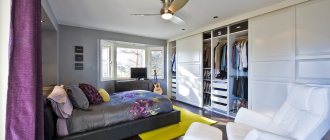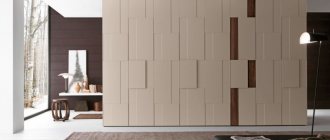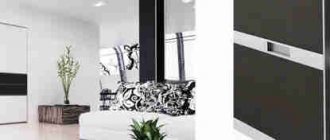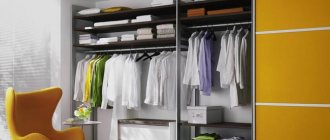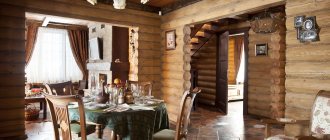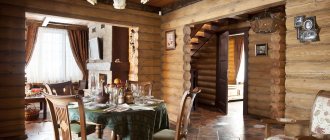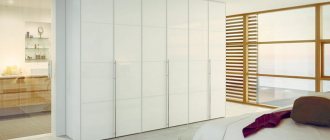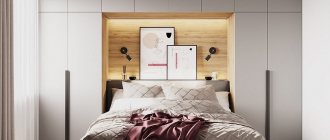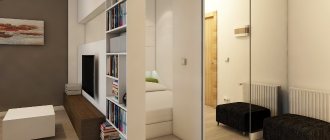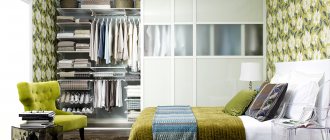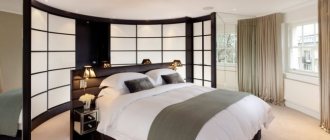Hi all! We talk a lot about how important it is to save space, choose the right furniture, and so on. But the question often arises as to what the inside of a corner cabinet should be like.
Yes, indeed, the question is quite relevant and important. The design of a corner cabinet, which can be concave, with different lengths of sides, is often installed in a bedroom or hallway, has a number of positive qualities. But the main problem is related to the internal filling. This is where mistakes are most often made.
It's all about filling and proper organization of the internal space. If the filling turns out to be incorrect due to the chosen scheme, then not only inside, but also outside the wardrobe will lose half of its advantages. The design can be cute and sophisticated. But when a person is simply uncomfortable using such furniture, this is a serious problem.
Types of built-in corner cabinets
It would seem, how many configurations can you come up with for a corner cabinet? It turns out that designers have a rich imagination. Judge for yourself.
- L-shaped . Two rectangular sections are connected at right angles. The most spacious option, which is also very careful about the square centimeters of your bedroom. Suitable for small rooms where every millimeter counts.
- Triangular . The facade connects two walls with one straight line, forming a triangular niche. With a large width, it does not use space efficiently. A competent layout of the interior space is needed. However, it is a very convenient option in small bedrooms where you need to smooth out corners and find space for narrow cabinets. If you need to hide someone in a closet, then this model is the most convenient for this case.
- Trapezoidal . Such modules are often used as components of complex structures. Unlike the triangular model, it is much more convenient to arrange shelves, rods and storage baskets.
- Radius . It is divided into concave and convex models. The first ones unobtrusively create additional volume. In fact, they serve as a modification of triangular cabinets. The latter play on L-shaped silhouettes. Soft lines fit well into modern, high-tech, romanticism, and eclecticism.
- Combined . Combines elements from the above models. For example, L-shaped with a wavy facade line.
- With open shelves . In some models it is convenient to leave open shelves. They can be used to store books, CDs, decorative porcelain, and flowers. The unusual shape of the shelves can become the highlight of the interior.
- With mezzanines . Sometimes the height of the ceilings allows you to place mezzanines on top or on the side of the cabinet. At the same time, you need to take into account that you should not hang them above the bed, since the module with things weighs quite a lot. It is better to place the mezzanine on a free wall. For example, above the desktop.
Features of filling (filling corners)
In corner wardrobes there are several “complex” compartments that need to be thought through for rational use. First of all, these are narrow triangles, in trapezoidal and diagonal models, on the sides of the main working volume. Most often, these compartments are filled with small shelves, perhaps wavy in shape. They are intended for small items or decorative items. Also creative ways to effectively use this area are to create closed hanging compartments for ties, niches for skis, umbrellas, and other long items.
One difficulty is the lintel at the right corner, especially for L-shaped cabinets. If it is nevertheless provided, then getting to the fenced off part of the space will be very difficult. It will be necessary to think through the purpose of this zone in advance, taking into account its rare use. It is used for storing rarely used or out-of-season clothing and household items of less frequent use.
Material
The cabinet consists of a frame, facade and internal filling. Since built-in models do not require back and sometimes side walls, more attention can be paid to the facades.
A metal profile or wooden beam is used for the frame. The side parts are usually made of MDF, chipboard or plastic.
For built-in wardrobes, you can use facades of various configurations:
- Sliding . As a rule, they use lightweight plastic with or without mirror coating. Laminated chipboard and MDF, glass are also often found. The array is rarely used, because it requires more powerful fittings.
- Swing . The doors simply swing open left or right. Natural wood and metal can be added to the above materials.
- Folding . They open by rotating around the horizontal axis of the lower or upper edge. Used to decorate small niches.
- Lifting . They rise up using a gas lift. Used for mezzanines and shelves located in the upper part of the cabinet.
- Accordion . The facade consists of several rectangular elements, which, when opened, are assembled in the form of an accordion. For their design, any materials are used, including fabric stretched over a frame.
In addition, the structure of the facades can be of different designs:
- straight;
- bent;
- with panels;
- smooth;
- with inserts;
- with stained glass;
- painted;
- with photo printing;
- sandblasting (monochrome and color);
- inlaid;
- with milled pattern;
- carved;
- painted;
- laminated.
Internal organization of space
To make things convenient to use, it is advisable to arrange them so that none of the household members have difficulty finding the desired item in the depths of the closet.
When planning departments, you need to take your wardrobe into account. How many items of one size or another, how extensive is the collection of shoes and bags.
Height of departments
- For dresses, coats and raincoats, set aside 150-180 cm. The remaining space at the bottom will be used for storing shoes in boxes or for vacuum bags.
- Shirts, blouses, shorts and trousers thrown over bars will require about 120 cm.
- For trousers hanging on clips, leave 140-150 cm.
- Summer shoes take up about 10-15 cm depending on the heel. The winter one is much higher and will require 20 to 30 cm.
- The fashion for tall hats has sunk into oblivion, so 20 cm is enough for them.
- It is convenient to store linen and knitwear in small piles so that they are easy to take out and put back. Convenient height of the linen shelves is 30 cm.
- Drawers and shelves for underwear and accessories usually take up from 5 to 15 cm, depending on what exactly will be stored.
Section width
If you're ordering a custom-sized closet, it makes sense to measure your laundry the way you usually fold it. Each housewife has her own system. Some people prefer the Japanese way of rolling things into rolls, while others traditionally form neat piles in the European style.
- Based on your personal preferences and traditions, from 30 to 60 cm are allocated for linen.
- Suitcases and travel bags take up from 60 to 80 cm.
- The length of the rod for dresses and trousers is no more than 1 m. Otherwise, it is necessary to provide additional support from below or above.
- Drawers and baskets take up from 30 to 80 cm, depending on their purpose.
- If you like to store things in boxes, then select containers and measure the width of the shelf, which is a multiple of the size of the box.
- End retractable rods are placed in niches 60 cm wide so that clothes have sufficient freedom and do not wrinkle.
Shades and sizes
Neutral shades of calm colors are considered more universal. These colors will not be annoying and annoying.
Charm and sophistication of the interior
These include:
- black;
- lactic;
- brown;
- beige;
- white and others.
Equipped with such a massive piece of furniture, the room can turn into gloomy and dark.
We play with space in different ways
To prevent this from happening, it is advisable to choose light shades for facades, decor with mirrors and light patterns.
An important point to note is the size of the valves. Sliding doors that reach the ceiling should be no more than 100 - 120 cm wide.
Bright print in snow-white version
If you choose wider doors, then using them will be more difficult and inconvenient.
Devices for convenient storage
Carousel for shoes
A great way to use deep corner niches. And it’s easy to compactly store a couple of dozen shoes. You can easily browse the available stock and choose the right model for your morning or evening outfit.
Pull-out shelf with compartments for ties and underwear
It is convenient to put small accessories and underwear in small cells so that you can see everything that is in stock. Pull-out shelves and drawers allow you to quickly make choices and bring order to your storage organization. Now you don't need to rummage through boxes looking for the right pair of socks.
Pull-out trouser
When you have a large collection of trousers in your wardrobe, it makes sense to purchase a retractable trouser rack for them, thanks to which things take up the minimum possible space in the closet. At the same time, they easily float right into your hands. Some trouser models are designed to automatically extend when the cabinet door is opened.
Retractable rod for tramples
End rods take up minimal space in the closet and allow you to compactly store shirts, suits, trousers, etc. To inspect things, just pull the bar towards you, and the closet will helpfully provide you with a wide selection of stored items.
Pull-out shelves for linen
A corner cabinet allows you to create deep shelves. However, this is not always convenient. Everything that ends up under the back wall on the shelves gets lost, forgotten and wastes space. There is an exit. Just make the shelves pull out. In this case, the overview of what is stored will increase significantly. You will always be aware of what is where. And at the same time, getting to the right thing will be easy and convenient, no matter where it is.
Laundry baskets
Knitwear does not like to be disturbed once again. Transparent containers and laundry baskets help extend the life of things. To make them convenient to use, order retractable models. In this case, any man will quickly navigate the depths of the closet and find the right thing without the help of his wife.
For vacuum cleaner
Vacuum cleaners are often stored in closets. All these hoses, tubes and nozzles strive to introduce an element of chaos into the ideal order that you have established. Therefore, for this cleaning assistant, set aside a separate place with hook holders for its parts. In this case, there will be order on every centimeter of your bedroom.
Shoe shelves
Typically, shoes are stored either at the bottom of the closet or in its drawers. However, this is not the only possible option. Take a closer look at how conveniently the pairs are located on store displays. Each one is visible. They take up very little space. Similar wire shelves can also be attached to the walls of the cabinet. And if there are a lot of shoes, but there is catastrophically little space, then you can resort to slider storage.
It would seem that what can be said about a simple wardrobe that is built into the corner of the bedroom? It turns out that this topic, like a good TV series, provides food for thought for more than one article. This time we touched only on the types of corner cabinets, materials and some tricks that make storing things convenient and practical.
Built-in corner wardrobes in the bedroom interior
Here is a current photo selection that will show what modern corner built-in wardrobes look like in a bedroom.
Tips for choosing
Making the right choice of a beautiful, functional piece of furniture requires a serious, responsible approach. First, decide on the place where the furniture will be located and its size. Pay close attention to the internal contents, quality of fittings and mechanisms. In order for such furniture to please with its design, the decorative finishing of the facade must be high-quality and beautiful; an unusual configuration of the product is possible. For example, a design with a rounded outline.
Taking into account all the parameters and nuances, you will receive a beautiful, multifunctional, comfortable, durable product - corner furniture in the form of a sliding wardrobe.
